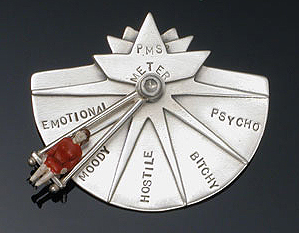Guest Post by David Linton, Marymount Manhattan College
 A lot of ideas get hatched in a bar over drinks with friends. Most don’t make it past the sober morning after. But a conversation in a Denver bistro in 2008 led to the creation of a new Internet service that aims to address Rodney King’s eternal question, “Can’t we all just get along?” In this case the “getting along” applies to men and women who feel afflicted by the scourge of Pre-Menstrual Syndrome – PMS – and its presumed negative impact on otherwise harmonious relationships.
A lot of ideas get hatched in a bar over drinks with friends. Most don’t make it past the sober morning after. But a conversation in a Denver bistro in 2008 led to the creation of a new Internet service that aims to address Rodney King’s eternal question, “Can’t we all just get along?” In this case the “getting along” applies to men and women who feel afflicted by the scourge of Pre-Menstrual Syndrome – PMS – and its presumed negative impact on otherwise harmonious relationships.
Despite the sound research and persuasive arguments of writers such as Carol Tavris (The Mismeasure of Woman), Anne Fausto-Sterling (Myths of Gender), Joan C. Chrisler (Charting a New Course for Feminist Psychology) and Paula Caplan (Fighting the Pathologizing of PMS), to name just a few who have labored to dispel the pernicious misconceptions and stigma surrounding the menstrual cycle, stereotypes and myths have been tenacious. Thus, in the digital age it was probably inevitable that PMS Lore would find new outlets for dissemination. Which brings us back to Denver.
One of the participants in the fateful exchange over Coors and coolers in the Mile High City was Jordan Eisenberg, a self-described entrepreneur. He and a group of friends had somehow gotten into a spirited conversation about PMS. The women expressed annoyance that men sometimes asked, “Are you getting your period?” as a way to discredit feelings women had about real concerns. It was so bad, they said, that even if they actually were menstruating, they could never acknowledge it because they’d be dismissed out of hand.
Opinions bounced around until one of the men mentioned that he put the date of his girl friend’s expected period in his Palm Pilot so he could anticipate her mood swings and avoid topics that might provoke conflict on “those days.” The men thought that this was a sensible idea, and the women were outraged that anyone would track their biology so mechanically.
For all but one of the participants the evening’s outing yielded no more than another story to share with friends at some future bar gathering. But for Jordan Eisenberg it was an inspiration. And so was born the Web site PMSBuddy.com.
In no time at all, the site has become an Internet hit. It can be found as an iPhone application and comes up under a number of Google search terms. Within a year of its launch, the site claimed to have 150,000 registered users and that it was currently tracking (as of 10/5/09) 33,192 menstrual cycles. According to the daily tally 1,366 women whose cycles were being tracked began to have PMS that day. Another 6,437 would begin within five days and the “Overall Threat Index” was “1-4:1,” whatever that means.
One might view the site as just a “guy joke,” another way for men to make light of something they don’t understand and to cope with their menstrual fears. The PMSBuddy web site uses fairly benign language and claims to have good intentions. It even has what it calls an “altruistic” aim with a slogan that boasts, “Saving relationships, one month at a time!” yet it reflects an underlying anxiety. It addresses male subscribers in a chummy voice: “PMSBuddy.com is a free service . . .to keep you aware of when . . . things can get intense for what may seem to be no reason at all. . . .there is no reason to ever be blindsided by PMS again.”
In addition to tracking the cycles of women in the lives of its subscribers and sending warning announcements about the impending periods of one’s wife, girlfriend, daughters, etc., it has a section called “PMS Stories,” submissions from subscribers about their PMS encounters and opinions. On the first day I first looked at the site there were nearly 150 stories posted from both men and women, but by the time these pages are being read there are surely many more.
My first reaction on discovering PMSbuddy.com was a combination of wonder and amusement.
Of course, this is not the first (nor, sadly, will it be the last) example of men taking cheap shots at menstruation or trying to turn prejudice to profit. An episode of In Living Color from 1991 (Season 2, episode 9) was titled “PMS Defense System” and featured Jim Carey in a mock ad for an emergency phone link that gave men 24 hour access to a woman who could talk you through any encounter with a woman afflicted with the disease of PMS.
 There are even efforts to turn PMS into an opportunity to make a fashion statement and source of income for a jewelry designer. Consider the PMS Meter Pen: A Warning System for Men. As the site states, “women who wrestle[s] with severe mood swings . . . owe it to the people around [them] to pick up this sterling silver PMS Meter Pin.” In effect, women are encouraged to internalize the menstrual stereotypes and, furthermore, spend $170.00 so they can advertise their compliance with the construction.
There are even efforts to turn PMS into an opportunity to make a fashion statement and source of income for a jewelry designer. Consider the PMS Meter Pen: A Warning System for Men. As the site states, “women who wrestle[s] with severe mood swings . . . owe it to the people around [them] to pick up this sterling silver PMS Meter Pin.” In effect, women are encouraged to internalize the menstrual stereotypes and, furthermore, spend $170.00 so they can advertise their compliance with the construction.
 Probably the most offensive online site dedicated to perpetuating the myths of PMS is called TrackYourBitch.com, a crass knock-off of PMSBuddy.com. It comes with an illustration of what the makers think a woman with PMS looks like, a hysterical screamer. Jordan Eisenberg finds this competitor offensive compared to his own site. “They copied us,” he said. “It goes too far. It’s derogatory and rude.. . . There’s not a classy way of doing what we’re doing but they go too far.”
Probably the most offensive online site dedicated to perpetuating the myths of PMS is called TrackYourBitch.com, a crass knock-off of PMSBuddy.com. It comes with an illustration of what the makers think a woman with PMS looks like, a hysterical screamer. Jordan Eisenberg finds this competitor offensive compared to his own site. “They copied us,” he said. “It goes too far. It’s derogatory and rude.. . . There’s not a classy way of doing what we’re doing but they go too far.”


To be honest, the idea of men tracking the cycles of the women in their lives doesn’t bother me nearly as much as the language they use on the website, or the absurd “Overall Threat Index.” Though I suppose the concept of tracking it for the sole purpose of self preservation because of the idea that all women turn into slavering, irrational beasts before they menstruate is a little ridiculous too. The only way I would really feel like I could endorse this wholeheartedly is if it was promoted in a way that fostered the understanding that whether or not a woman has PMS, her concerns and emotions are important and not to be dismissed because it’s “that time.”
Maybe if they were tracking it so they could better understand the fertility of the women in their lives it would be a bit better. I would actually welcome any attempts by my partner to better understand my fertility.
I think it’s rather creepy. How much you want to bet that most of those recorded cycles are recorded without consent? At the very least that seems like a gross breach of privacy… very ick.